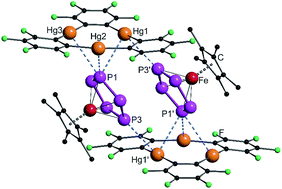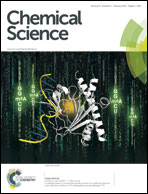A comparative study of the coordination behavior of cyclo-P5 and cyclo-As5 ligand complexes towards the trinuclear Lewis acid complex (perfluoro-ortho-phenylene)mercury†
Abstract
Reactions of the cyclo-E5 sandwich complexes [Cp*Fe(η5-P5)] (1) and [Cp*Fe(η5-As5)] (2) with the planar Lewis acid trimeric (perfluoro-ortho-phenylene)mercury [(o-C6F4Hg)3] (3) afford compounds that show distinctly different assemblies in the solid state. The phosphorus containing ligand 1 forms dimeric coordination units with two molecules of 3, with one P atom of each cyclo-P5 ligand positioned in close proximity to the center of a molecule of 3. In contrast to the coordination behavior of 1, the arsenic analog 2 shows simultaneous interaction of three As atoms with the Hg atoms of 3. A DFT study and subsequent AIM analyses of the products suggest that electrostatic forces are prevalent over donor–acceptor interactions in these adducts, and may play a role in the differences in the observed coordination behavior. Subsequently, a series of [CpRFe(η5-P5)] (CpR = C5H5−ntBun, n = 1–3, 6a–c) sandwich complexes was prepared and also reacted with [(o-C6F4Hg)3]. In the solid state the obtained products 7a–c with increasing steric demand of the CpR ligands show no significant change in their assembly compared to the Cp* analog 4. All of the products were characterized by single crystal X-ray structure analysis, mass spectrometry and elemental analysis as well as NMR spectroscopy and IR spectrometry.


 Please wait while we load your content...
Please wait while we load your content...